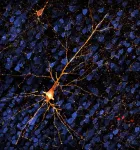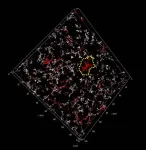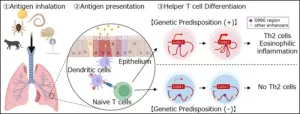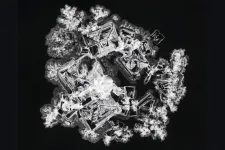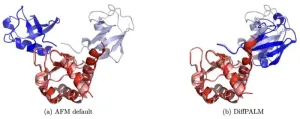(Press-News.org) When neuroscientists think about the strategy an animal might use to carry out a task – like finding food, hunting prey, or navigating a maze – they often propose a single model that lays out the best way for the animal to accomplish the job.
But in the real world, animals – and humans – may not use the optimal way, which can be resource intensive. Instead, they use a strategy that’s good enough to do the job but takes a lot less brain power.
In new research, Janelia scientists set out to better understand the possible ways an animal could successfully solve a problem, beyond just the best strategy.
The work shows there are a huge number of ways an animal can accomplish a simple foraging task. It also lays out a theoretical framework for understanding these different strategies, how they relate to each other, and how they solve the same problem differently.
Some of these less-than-perfect options for accomplishing a task work nearly as well as the optimal strategy but with a lot less effort, the researchers found, freeing up animals to use precious resources to handle multiple tasks.
“As soon as you release yourself from being perfect, you would be surprised just how many ways there are to solve a problem,” says Tzuhsuan Ma, a postdoc in the Hermundstad Lab who led the research.
The new framework could help researchers start examining these “good enough” strategies, including why different individuals might adapt different strategies, how these strategies might work together, and how generalizable the strategies are to other tasks. That could help explain how the brain enables behavior in the real world.
“Many of these strategies are ones we would have never dreamed up as possible ways of solving this task, but they do work well, so it’s entirely possible that animals could also be using them,” says Janelia Group Leader Ann Hermundstad. “They give us a new vocabulary for understanding behavior.”
Looking beyond perfection
The research began three years ago when Ma started wondering about the different strategies an animal could possibly use to accomplish a simple but common task: choosing between two options where the chance of being rewarded changes over time.
The researchers were interested in examining a group of strategies that fall between optimal and completely random solutions: “small programs” that are resource-limited but still get the job done. Each program specifies a different algorithm for guiding an animal’s actions based on past observations, allowing it to serve as a model of animal behavior.
It turns out, there are a lot of such programs – about a quarter of a million. To make sense of these strategies, the researchers first looked at a handful of the top performing ones. Surprisingly, they found they were essentially doing the same thing as the optimal strategy, despite using fewer resources.
“We were a little disappointed,” Ma says. “We spent all this time searching for these small programs, and they all follow the same computation that the field already knew how to mathematically derive without all this effort.”
But the researchers were motivated to keep looking – they had a strong intuition that there had to be programs out there that were good but different from the optimal strategy. Once they looked beyond the very best programs, they found what they were looking for: about 4,000 programs that fall into this “good enough” category. And more importantly, more than 90 percent of them did something new.
They could have stopped there, but a question from a fellow Janelian spurred them on: How could they figure out which strategy an animal was using?
The question prompted the team to dive deep into the behavior of individual programs and develop a systematic approach to thinking about the entire collection of strategies. They first developed a mathematical way to describe the programs’ relationships to each other through a network that connected the different programs. Next, they looked at the behavior described by the strategies, devising an algorithm to reveal how one of these “good enough” programs could evolve from another.
They found that small changes to the optimal program can lead to big changes in behavior while still preserving performance. If some of these new behaviors are also useful in other tasks, it suggests that the same program could be good enough for solving a range of different problems.
“If you are thinking about an animal not being a specialist who is optimized to solve just one problem, but rather a generalist who solves many problems, this really is a new way to study that,” Ma says.
The new work provides a framework for researchers to start thinking beyond single, optimal programs for animal behavior. Now, the team is focused on examining how generalizable the small programs are to other tasks and designing new experiments to determine which program an animal might be using to carry out a task in real time. They are also working with other researchers at Janelia to test their theoretical framework.
“Ultimately, getting a strong grasp on an animal’s behavior is an essential prerequisite to understanding how the brain solves different types of problems, including some that our best artificial systems only solve inefficiently, if at all,” Hermundstad says. “The key challenge is that animals might be using very different strategies than we might initially assume, and this work is helping us uncover that space of possibilities.”
END
New research shows why you don’t need to be perfect to get the job done
2024-06-24
ELSE PRESS RELEASES FROM THIS DATE:
Detection and genetic analysis of songling virus in Haemaphysalis concinna near the China-North Korea Border
2024-06-24
https://www.scienceopen.com/hosted-document?doi=10.15212/ZOONOSES-2024-0004
Announcing a new article publication for Zoonoses journal. Songling virus (SGLV) is a spherical, enveloped, fragmented, negative-stranded RNA virus belonging to the genus Orthonairovirus in the Nairoviridae family. SGLV is transmitted by ticks and can cause disease in humans. This study identified and characterized SGLV in Haemaphysalis concinna ticks collected in 2023 in the Yanbian Korean Autonomous Prefecture (China) near the China-North Korea border.
A real-time quantitative ...
Leading the way in nursing home care
2024-06-24
A researcher at the University of Missouri has developed a program that improves the quality of care and reduces avoidable hospitalizations in nursing homes — saving Missouri nursing homes and Medicare millions of dollars and allowing Missouri nursing homes to invest more in retaining their most skilled staff members. The program is so successful that it’s being recommended for use in all 50 states.
The Quality Improvement Program for Missouri (QIPMO) was created by Marilyn Rantz in 1999 as a partnership between Mizzou’s Sinclair School of Nursing and the Missouri Department of Health and Senior Services.
For the past 25 years, the program has allowed Rantz and ...
Exploring early stage Alzheimer’s disease
2024-06-24
Research in nonhuman primates is opening the possibility of testing treatments for the early stages of Alzheimer’s and similar diseases, before extensive brain cell death and dementia set in. A study published June 21 in Alzheimer’s & Dementia: The Journal of the Alzheimer’s Association shows up to a six-month window in which disease progress could be tracked and treatments tested in rhesus macaques.
“This is a very powerful translational model to test interventions that target the tau protein,” said John H. ...
University of Cincinnati study: Signaling pathway in brain helps maintain balance, prevent cognitive deficit
2024-06-24
A new study led by University of Cincinnati researchers sheds new light on the role of a signaling pathway in the brain to maintain health and prevent inflammation and cognitive deficits.
UC’s Agnes (Yu) Luo, PhD, is corresponding author on the research, published June 21 in the journal Nature Communications, and focused on a signaling pathway called TGF-β that plays a number of roles depending on where it is located in the body.
Luo explained that signaling pathways in the body control different cell functions and require two components: a type of molecule called a ligand and a receptor that the ligand binds to and ...
Bank statements reveal clues to excessive spending and cognitive decline
2024-06-24
DETROIT -- Early memory loss has been linked to wealth loss, but research has mostly focused on investments. Four years ago, clinical geropsychologist Peter Lichtenberg, Ph.D., wondered what clues might be found in an older person’s financial decisions to indicate their vulnerability to financial victimization. Lichtenberg is director of the Institute of Gerontology at Wayne State University and a national expert in the financial exploitation of older adults. The results of his curiosity have now been published as “The WALLET Study: Financial ...
Even very small amounts of elements in follicular fluid may impact IVF success rates, according to new study from George Mason University researcher
2024-06-24
Though exposure to “trace” (an extremely small amount) elements has been shown to affect ovarian functions in experimental studies, there has been little research on the impact of trace levels of non-essential elements, such as lead (Pb) and mercury (Hg), on female reproduction. Studies have shown that high levels of these non-essential elements may lead to decreased female fertility and reduce the likelihood of getting pregnant. Taken together, this evidence raises concern about the potential negative impact of exposure ...
Study elucidates role of “G900” gene enhancers in asthma-associated inflammation
2024-06-24
Asthma patients experience respiratory distress due to allergens like house dust mites or pollen. However, the various triggers for asthma share a common pathway involving the release of proteins called type-2 cytokines by Type-2 helper T (Th2) cells and group-2 innate lymphoid cells (ILC2s). Both Th2 and ILC2 require high amounts of GATA-binding protein 3 (GATA3) for their maturation.
Specific gene sequences called enhancers are responsible for elevating the expression of GATA3 genes in humans. Studies have found that by controlling the production of GATA3, enhancers influence the development of Th2 and ILC2. The gene region G900, located close to ...
Secrets of drop stains unveiled: New FSU research decodes chemical composition from simple photos
2024-06-24
TALLAHASSEE, Fla. — Imagine zooming in on a dried drop of salt solution — each pattern a unique masterpiece, reminiscent of abstract art, yet no larger than the size of a penny.
New research by scientists in the Florida State University Department of Chemistry and Biochemistry uses the patterns formed by a dried salt solution to train a machine learning algorithm that can identify the chemical composition of different salts. The work will be published in the Proceedings of the National Academy of Sciences.
“We are taking chemical fingerprints ...
New computational model of real neurons could lead to better AI
2024-06-24
Nearly all the neural networks that power modern artificial intelligence tools such as ChatGPT are based on a 1960s-era computational model of a living neuron. A new model developed at the Flatiron Institute’s Center for Computational Neuroscience (CCN) suggests that this decades-old approximation doesn’t capture all the computational abilities that real neurons possess and that this older model is potentially holding back AI development.
The new model developed at CCN posits that individual neurons exert more control over their surroundings than previously thought. The updated neuron model could ultimately lead to more powerful artificial neural ...
AI matches protein interaction partners
2024-06-24
Proteins are the building blocks of life, involved in virtually every biological process. Understanding how proteins interact with each other is crucial for deciphering the complexities of cellular functions, and has significant implications for drug development and the treatment of diseases.
However, predicting which proteins bind together has been a challenging aspect of computational biology, primarily due to the vast diversity and complexity of protein structures. But a new study from the group of Anne-Florence Bitbol at EPFL might now change all that.
The team of scientists, ...

